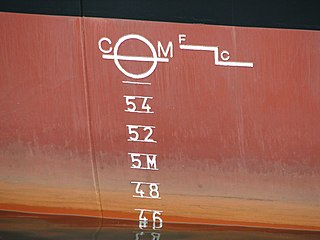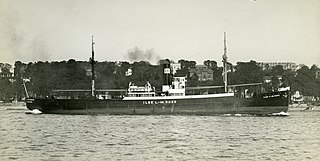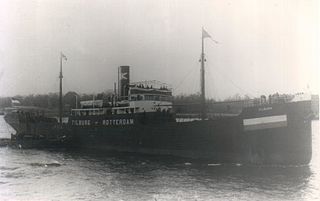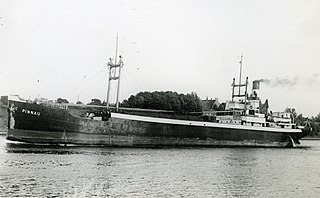Related Research Articles

Samuel Plimsoll was a British politician and social reformer, now best remembered for having devised the Plimsoll line.

A coffin ship is a popular idiom used to describe the ships that carried Irish migrants escaping the Great Irish Famine and Highlanders displaced by the Highland Clearances.

The Flying Dutchman is a legendary ghost ship, allegedly never able to make port, but doomed to sail the seven seas forever. The myths and ghost stories are likely to have originated from the 17th-century Golden Age of the Dutch East India Company (VOC) and of Dutch maritime power. The oldest known extant version of the legend dates from the late 18th century. According to the legend, if hailed by another ship, the crew of the Flying Dutchman might try to send messages to land, or to people long dead. Reported sightings in the 19th and 20th centuries claimed that the ship glowed with a ghostly light. In ocean lore, the sight of this phantom ship functions as a portent of doom. It was commonly believed that the Flying Dutchman was a seventeenth-century cargo vessel known as a fluyt.

The waterline is the line where the hull of a ship meets the surface of the water. Specifically, it is also the name of a special marking, also known as an international load line, Plimsoll line and water line, that indicates the draft of the ship and the legal limit to which a ship may be loaded for specific water types and temperatures in order to safely maintain buoyancy, particularly with regard to the hazard of waves that may arise. Varying water temperatures will affect a ship's draft, because warm water is less dense than cold water, providing less buoyancy. In the same way, fresh water is less dense than salinated or seawater with a similar lessening effect upon buoyancy.

The Survivors of the Chancellor: Diary of J. R. Kazallon, Passenger is an 1875 novel written by Jules Verne about the final voyage of a British sailing ship, the Chancellor, told from the perspective of one of its passengers.

SS London was a British steamship that sank in the Bay of Biscay on 11 January 1866. The ship was travelling from Gravesend, England to Melbourne, Australia, when she began taking in water on 10 January, with 239 persons aboard. The ship was overloaded with cargo, and thus unseaworthy, and only 19 survivors were able to escape the foundering ship by lifeboat, leaving a death toll of 220.

Georges Philippar was an ocean liner of the French Messageries Maritimes line that was built in 1930. On her maiden voyage in 1932 she caught fire and sank in the Gulf of Aden with the loss of 54 lives.
Lucona was a ship sunk in the Indian Ocean on 23 January 1977 by a bomb planted by Austrian businessman Udo Proksch, as part of an insurance fraud. Proksch, the owner of the cargo, also then-owner of famous Viennese confectioners Demel, claimed 212 million schilling from his insurance company, saying that the cargo was expensive uranium mining equipment. He was subsequently convicted in 1991 of the murder of six crew who were killed by the explosion. Proksch died in prison in 2001.
Charlotte Cords was a cargo ship that was built in 1923 by Neptun AG, Rostock for German owners. She was seized by the Allies in Travemünde in May 1945, passed to the Ministry of War Transport (MoWT) and renamed Empire Connah. In 1946, she was allocated to the Soviet Government and renamed Nikolai Bauman. The ship was scuttled while carrying a cargo of nuclear waste in 1964.

Ilse L.-M. Russ was a 1,600 GRT cargo ship that was built in 1926 by Flensburger Schiffbau Gesellschaft, Flensburg. She was seized by the Allies in May 1945 at Kiel, passed to the Ministry of War Transport (MoWT) and renamed Empire Conqueror. In 1946, she was allocated to the Norwegian Government and renamed Ekornes. She was sold into merchant service in 1947 and renamed Elfrida. She served until December 1959 when she sprang a leak and sank off the coast of Norway.

Ljusneälf was a 1,391 GRT cargo ship that was built in 1917 as Tilburg by L Smit & Zoon, Kinderdijk for Dutch owners. She was sold to German owners in 1922 and renamed Ljusneälf. A sale in 1938 saw her renamed Hubert Schröder. She was seized by the Allies in April 1945, passed to the Ministry of War Transport (MoWT) and renamed Empire Conquest.
Dollart was a 535 GRT coaster that was built in 1912 by Stettiner Oderwerke AG, Stettin, Germany for German owners. She was seized by the Allies in May 1945, passed to the Ministry of War Transport (MoWT) and was renamed Empire Constancy. In 1947, she was sold into merchant service and renamed Polzeath. In 1951, she was sold to Turkey and renamed Meltem. Further sales saw her renamed Yener 9 in 1956 and Yarasli in 1959. She went missing in the Ionian Sea in January 1961.
Memel was a 1,102 GRT cargo ship that was built in 1925 as Reval by Schiffs-und Dockbauwerft Flender AG, Lübeck, Germany for German owners. A sale in 1934 saw her renamed Memel. She was seized by the Allies in May 1945, passed to the Ministry of War Transport (MoWT) and was renamed Empire Constellation. In 1946, she was transferred to the Soviet Union and renamed Ivan Sechenov.

Pinnau was a 1,198 GRT cargo ship that was built in 1922 by Nobiskrug Werft GmbH, Rendsburg, Germany for German owners. She was seized by the Allies in May 1945, passed to the Ministry of War Transport (MoWT) and was renamed Empire Constructor. In 1947, she was sold into merchant service and renamed Estkon. She served until 1959 when she was scrapped.
Jean Marie was a 964 GRT coaster that was built in 1922 by F Schichau GmbH, Elbing, Germany as Tertia for German owners. A sale in 1925 saw her renamed Hornland. In 1926, a further sale saw her renamed Taube. She was seized by the Allies in May 1945, passed to the Ministry of War Transport (MoWT) and was renamed Empire Contour. In 1946, she was transferred to Belgium and renamed Jean Marie. She was sold into merchant service, serving until 1951 when she sank after her cargo shifted.
Scantic was a 326 GRT coaster that was built in 1936 by Noord Nederland Scheepsmakkerij, Groningen as Dr Colijn for a Dutch owner. In 1940, she was transferred to the Ministry of War Transport (MoWT) and renamed Empire Crocus. In 1947, she was sold into merchant service and renamed Stainton. A further sale in 1951 saw her renamed Benwood. In 1955 she was sold to Finland and renamed Monica. A further sale to Sweden in 1957 saw her renamed Mona. In 1963, she was sold to Denmark and renamed Scantic, serving until 7 December 1964 when she foundered in St Georges Channel, United Kingdom.

HMAS Mallina was a 3,213 GRT cargo ship built by Harland & Wolff, Belfast in 1909 as Mallina for the Australian United Steam Navigation Company for the Rockhampton to Sydney cargo route. She was requisitioned by the Royal Australian Navy in 1914, as a store carrier and collier. She was returned to her owners in 1915. She was sold in 1935 to Machida Shokai Kisen Kaisha, Japan and renamed Seiko Maru, before being sold to Kita Nippon Kisen Kaisha and renamed Siberia Maru No. 3, which was later shortened to Siberian Maru. While steaming in the Sulu Sea, Philippines on 24 September 1944, she was attacked by American aircraft of Task Force 38 and sunk with the loss of 158 of the 2,382 people on board.
MV Vinalines Queen was a bulk carrier of the Vietnam National Shipping Lines, or Vinalines. On its last voyage the ship was travelling from Indonesia to China with more than 54,000 tonnes of nickel ore. The ship disappeared on 25 December 2011 and its fate was initially unknown. On 30 December 2011 a single survivor of its 23-member crew, Dau Ngoc Hung, was found by the British ship London Courage, after floating with a rescue vest for 5 days. He reported that the ship sank quickly in the early hours of the morning after capsizing to the left. It sank after passing the island of Luzon in very bad weather conditions in waters up to 5,000 metres (16,000 ft) deep.
MV Asia South Korea was a Philippines passenger ferry owned by Trans-Asia Shipping Lines that sank off Bantayan Island in Cebu province on 23 December 1999. It was discovered that the number of passengers aboard exceeded the total capacity of the 27-year-old ferry.
MV Salvador Allende was a cargo ship that sank in December 1994 in the North Atlantic Ocean with the loss of 29 of her 31 crew members.
References
- ↑ Plimsoll Line and Coffin Ships
- ↑ Jones Nicolette. 2006. The Plimsoll Sensation : The Great Campaign to Save Lives at Sea. London: Little Brown.
- ↑ Coast (TV series), episode "Hull to London"
- ↑ "Merchant Shipping Act". Spartacus Educational . SchoolNet. Archived from the original on 3 April 2013. Retrieved 30 March 2013.
- ↑ "Parliament — Breach of Order (Mr. Plimsoll)". Hansard, 22 July 1875. Millbank Systems. 22 July 1875. Retrieved 30 March 2013.
- ↑ "The Lucona Affair". Chicago Tribune . March 15, 1989.